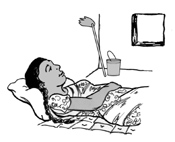| Before the procedure the woman should |
- Use another contraceptive until the procedure.
- Not eat anything for 8 hours before surgery. She can drink clear liquids until 2 hours before surgery.
- Not take any medication for 24 hours before the surgery (unless she is told to do so).
- Wear clean, loose-fitting clothing to the health facility if possible.
- Not wear nail polish or jewelry.
- If possible, bring a friend or relative to help her go home afterwards.
|
After the procedure the woman should
 |
- Rest for 2 days and avoid vigorous work and heavy lifting for a week.
- Keep incision clean and dry for 1 to 2 days.
- Avoid rubbing the incision for 1 week.
- Not have sex for at least 1 week. If pain lasts more than 1 week, avoid sex until all pain is gone.
|
| What to do about the most common problems |
- She may have some abdominal pain and swelling after the procedure. It usually goes away within a few days. Suggest ibuprofen (200–400 mg), paracetamol (325–1000 mg), or other pain reliever. She should not take aspirin, which slows blood clotting. Stronger pain reliever is rarely needed. If she had laparascopy, she may have shoulder pain or feel bloated for a few days.
|
| Plan the follow-up visit |
- Following up within 7 days or at least within 2 weeks is strongly recommended. No woman should be denied sterilization, however, because follow-up would be difficult or not possible.
- A health care provider checks the site of the incision, looks for any signs of infection, and removes any stitches. This can be done in the clinic, in the client's home (by a specifically trained paramedical worker, for example), or at any other health center.
|